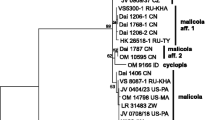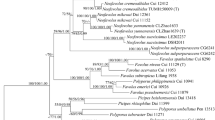Abstract
Species of the genus Sparassis in East Asia were investigated using morphology and DNA sequences data. Phylogenetic analyses inferred from sequences of the internal transcribed spacer (ITS), the nuclear gene coding for the ribosomal large subunit (nLSU) and partial gene coding RNA polymerase subunit II (rpb2) strongly supported lineages corresponding to morphological features. Three taxa, S. subalpina, S. cystidiosa f. flabelliformis and S. latifolia were recognized from East Asia, and the former two taxa are new to science. The occurrence of S. latifolia in Japan and in the Russian Far East was confirmed. Geographical divergences of Sparassis in the Holarctic were observed. Most species have relatively narrow distribution ranges, and taxa with intercontinental distributions were not detected. Divergence of species in the Northern Hemisphere in different clades appears to have taken place at different times: the S. latifolia-crispa-radicata species complex appears to have undergone a recent radiation, while the S. subalpina-brevipes-spathularia species complex represents a relatively ancient speciation.




Similar content being viewed by others
References
Blanco-Dios JB, Wang Z, Binder M, Hibbett DS (2006) A new Sparassis species from Spain described using morphological and molecular data. Mycol Res 10:1227–1231
Burdsall HH Jr, Miller OK Jr (1988) Type studies and nomenclatural considerations in the genus Sparassis. Mycotaxon 31:199–206
Dai YC, Wang Z, Binder M, Hibbett DS (2006) Phylogeny and a new species of Sparassis (Polyporales, Basidiomycota): evidence from mitochondrial atp6, nuclear rDNA and rpb2 genes. Mycologia 98:584–592
Dentinger BTM, Ammirati JF, Both EE, Desjardin DE, Halling RE, Henkel TW, Moreau PA, Nagasawa E, Soytong K, Taylor AF, Watling R, Moncalvo JM, Mclaughlin DJ (2010) Molecular phylogenetics of porcini mushrooms (Boletus section Boletus). Mol Phylogenet Evol 57:1276–1292
Desjardin DE, Wang Z, Binder M, Hibbett DS (2004) Sparassis cystidiosa sp. nov., from Thailand is described using morphological and molecular data. Mycologia 96:1010–1014
Donoghue MJ, Smith SA (2004) Patterns in the assembly of temperate forests around the Northern Hemisphere. Phil Trans R Soc B 359:1633–1644
Doyle JJ, Doyle JL (1987) A rapid DNA isolation procedure for small quantities of fresh leaf tissue. Phytochem Bull 19:11–15
Du XH, Zhao Q, O’Donnell K, Rooney AP, Yang ZL (2012) Multigene molecular phylogenetics reveals true morels (Morchella) are especially species-rich in China. Fungal Genet Biol 49:455–469
Feng B, Xu J, Wu G, Hosen MI, Zeng NK, Li YC, Tolgor B, Kost GW, Yang ZL (2012) DNA sequence analyses reveal abundant diversity, endemism and evidence for Asian origin of the Porcini Mushrooms. PLoS One. doi:10.1371/journal.pone.0037567
Garnica S, Spahn P, Oertel B, Ammirati J, Oberwinkler F (2011) Tracking the evolutionary history of Cortinarius species in section Calochroi, with transoceanic disjunct distribution. BMC Evol Biol 11:213. doi:10.1186/1471-2148-11-213
Geml J, Laursen GA, ONeill K, Nusbaum HC, Taylor DL (2006) Beringian origins and cryptic speciation events in the fly agaric (Amanita muscaria). Mol Ecol 15:225–239
Geml J, Tulloss RE, Laursen GA, Sazanova NA, Taylor DL (2008) Evidence for strong inter- and intracontinental phylogeographic structure in Amanita muscaria, a wind-dispersed ectomycorrhizal basidiomycete. Mol Phylogenet Evol 48:694–701
Hall TA (1999) BioEdit: a user-friendly biological sequence alignment editor and analysis program for Windows 95/98/NT. Nucleic Acids Symp Ser 41:95–98
Halling RE (2001) Ectomycorrhizae: co-evolution, significance, and biogeography. Ann Mo Bot Gard 88:5–13
Hosaka K, Castellano MA, Spatafora JW (2008) Biogeography of hysterangiales (Phallomycetidae, Basidiomycota). Mycol Res 112:448–462
Imazeki R, Otani Y, Hongo T (1988) Fungi of Japan. Yama-Kei Publishers Co. Ltd, Tokyo
Kreisel H (1983) Zur Taxonomie von Sparassis laminosa Fr. s. l. Fedd Rep 94:675–682
Li YC, Yang ZL, Tolgor B (2009) Phylogenetic and biogeographic relationships of Chroogomphus species as inferred from molecular and morphological data. Fungal Divers 38:85–104
Li YC, Feng B, Yang ZL (2011) Zangia, a new genus of Boletaceae supported by molecular and morphological evidence. Fungal Divers 49:125–143
Liang JF, Yang ZL, Xu DP (2011) A new species of Lepiota from China. Mycologia 103:820–830
Liu K, Raghavan S, Nelesen S, Linder CR, Warnow T (2009) Rapid and accurate large-scale coestimation of sequence alignments and phylogenetic trees. Science 324:1561–1564
Mao XL (1998) Economic fungi of China (in Chinese). Science Press, Beijing
Mao XL (2000) Macrofungi of China (in Chinese). Henan Science and Technology Press, Zhengzhou
Mueller GM, Wu QX, Huang YQ, Guo SY, Aldana-Gomez R, Vilgalys R (2001) Assessing biogeographic relationships between North American and Chinese macrofungi. J Biogeogr 28:271–281
Petersen RH, Hughes KW (2007) Some agaric distribution patterns involving Pacific landmasses and Pacific Rim. Mycoscience 48:1–14
Redhead SA (1989) A biogeographical overview of the Canadian mushroom flora. Can J Bot 67:3003–3062
Swofford DL (2002) PAUP*. Phylogenetic analysis using parsimony (* and other methods), Version 4.01. Sinauer, Sunderland
Vilgalys R, Hester M (1990) Rapid genetic identification and mapping of enzymatically amplified ribosomal DNA from several Cryptococcus species. J Bacteriol 172:4238–4246
Vincenot L, Nara K, Sthultz C, Labbe J, Dubois MP, Tedersoo L, Martin F, Selosse MA (2012) Extensive gene flow over Europe and possible speciation over Eurasia in the ectomycorrhizal basidiomycete Laccaria amethystina complex. Mol Ecol 21:281–299
Wang Z, Binder M, Dai YC, Hibbett DS (2004) Phylogenetic relationships of Sparassis inferred from nuclear and mitochondrial ribosomal DNA and RNA polymerase sequences. Mycologia 95:1008–1012
Wang Z, Nilsson RH, Lopez-Giraldez F, Zhuang WY, Dai YC, Johnston PR, Townsend JP (2011) Tasting soil fungal diversity with earth tongues: phylogenetic test of SATe’alignments for environmental ITS data. PLoS One 6(4):e19039. doi:10.1371/journal.pone.0019039
White TJ, Bruns T, Lee S, Taylor J (1990) Amplification and direct sequencing of fungal ribosomal RNA genes for phylogeneties. In: Innis MA, Gelfand DH, Sninsky JJ, White JW (eds) PCR Protocols: a guide to methods and applications. Academic, New York, pp 315–322
Yang ZL (2011) Molecular techniques revolutionize knowledge of basidiomycete evolution. Fungal Divers 50:47–58
Yang ZL, Li YC, Tang LP, Shi GQ, Zeng G (2012) Trogia venenata (Agaricales), a novel poisonous species which has caused hundreds of deaths in southwestern China. Mycol Prog. doi:10.1007/s11557-012-0809-y
Ying JZ, Zang M (1994) Economic macrofungi from southwestern China (in Chinese). Science Press, Beijing
Yuan MS, Sun PQ (2007) Atlas of Chinese mushrooms (in Chinese). Sichuan Publishing House of Science and Technology Press, Chengdu
Zang M, Li B, Xi JX (1996) Fungi of the Hengduan mountains (in Chinese). Science Press, Beijing
Zeng NK, Tang LP, Li YC, Tolgor B, Zhu XT, Zhao Q, Yang ZL (2012) The genus Phylloporus (Boletaceae, Boletales) from China: morphological and multilocus DNA sequence analyses. Fungal Divers. doi:10.1007/s13225-012-0184-7
Zhang LF, Yang JB, Yang ZL (2004) Molecular phylogeny of eastern Asian species of Amanita (Agaricales, Basidiomycota): taxonomic and biogeographic implications. Fungal Divers 17:219–238
Acknowledgments
This study was supported by the Natural Science Foundation of Yunnan Province (2008CD185), the Research Fund for the Large-scale Scientific Facilities of the Chinese Academy of Sciences (2009-LSF-GBOWS-01), and the Ministry of Science and Technology of the People’s Republic of China (2008FY110300).The anonymous reviewers are gratefully acknowledged for providing constructive comments and linguistic improvements.
Author information
Authors and Affiliations
Corresponding author
Rights and permissions
About this article
Cite this article
Zhao, Q., Feng, B., Yang, Z.L. et al. New species and distinctive geographical divergences of the genus Sparassis (Basidiomycota): evidence from morphological and molecular data. Mycol Progress 12, 445–454 (2013). https://doi.org/10.1007/s11557-012-0853-7
Received:
Revised:
Accepted:
Published:
Issue Date:
DOI: https://doi.org/10.1007/s11557-012-0853-7




